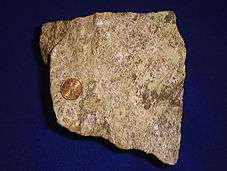Rare-earth mineral
A rare-earth mineral contains one or more rare-earth elements as major metal constituents. Rare-earth minerals are usually found in association with alkaline to peralkaline igneous complexes, in pegmatites associated with alkaline magmas and in or associated with carbonatite intrusives. Perovskite mineral phases are common hosts to rare-earth elements within the alkaline complexes. Mantle-derived carbonate melts are also carriers of the rare earths. Hydrothermal deposits associated with alkaline magmatism contain a variety of rare-earth minerals.

The following includes the relatively common hydrothermal rare-earth minerals and minerals that often contain significant rare-earth substitution:
- aeschynite
- allanite
- apatite
- bastnäsite
- britholite
- brockite
- cerite
- fluocerite
- fluorite
- gadolinite
- monazite
- parisite
- stillwellite
- synchysite
- titanite
- wakefieldite
- xenotime
- zircon
Production
The mining of rare-earth minerals was at one time dominated by the United States. China has since come to dominate the market. In response to the Chinese supply instability,[1] Japan tried to cut its dependency on China by importing from Vietnam and other countries.[2]
References
- Jones, Adrian P., Francis Wall and C. Terry Williams, eds. (1996) Rare Earth Minerals: Chemistry, Origin and Ore Deposits, The Mineralogy Society Series #7, 372 pp. ISBN 978-0-412-61030-1
- SHIDA, TOMIO. "History offers lessons in escaping China's rare-earth dominanc". Nikkei Asian Review. Retrieved 21 December 2019.
- Matt McGrath, Asian countries challenge China on rare earth minerals. BBC News. 20 June 2012